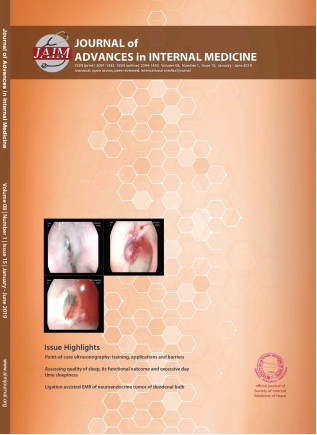Assessing quality of sleep, its functional outcome and excessive day time sleepiness in shift workers and non-shift workers
DOI:
https://doi.org/10.3126/jaim.v8i1.27999Keywords:
Shift workers, sleep apnea, sleep qualityAbstract
Background and Aims: Shift work has been growing more prevalence and involves irregular working hours when compared to daytime work schedule. This study aims to assess sleep quality, its functional outcome, excessive daytime sleepiness and incidence of obstructive sleep apnea between shift and non-shift workers.
Methods: The study candidates were randomly drawn Nepalese, from age 18 years and older, and were enrolled between January 2018 to January 2019. The subjects were divided into either: Shift work or Non-Shift work. The assessment measures were done with Pittsburgh Sleep Quality Index (PSQI), Epworth Sleepiness Scale (ESS), STOP-BANG and FOSQ-10 (Functional Outcome of Sleep Quality – 10), using a standard form.
Results: A total of 358 participants were included in the main study (176 Non-shift workers, and 182 Shift-workers). The mean BMI among the two group were not significantly different (p =0.43). There was significant difference with 25% Non-Shift workers and 41.21% of Shift workers were found to have Abnormal Sleepiness in the Epworth Sleepiness Scale score (p=0.004). Shift workers showed comparatively higher values for Epworth Sleepiness scale compared to Non-Shift workers in Mann-Whitney analysis, with mean rank 194.11 versus 164.39, respectively, p=0.006. Similarly, 26.29% Non-Shift workers and 36.72% Shift workers were found to have abnormal FOSQ-10 scores, χ2 (1) =4.44, p=0.035. 7.95% of Non-Shift workers and 6.59% of Shift-workers were found to have high risk of OSA in STOP BANG questionnaire, with no significant association, p=0.725.
Conclusions: Shift work caused excessive daytime sleepiness and had worse functional outcome but did not increase probability of obstructive sleep apnea.
Downloads
Downloads
Published
How to Cite
Issue
Section
License
This license enables reusers to distribute, remix, adapt, and build upon the material in any medium or format, so long as attribution is given to the creator.




